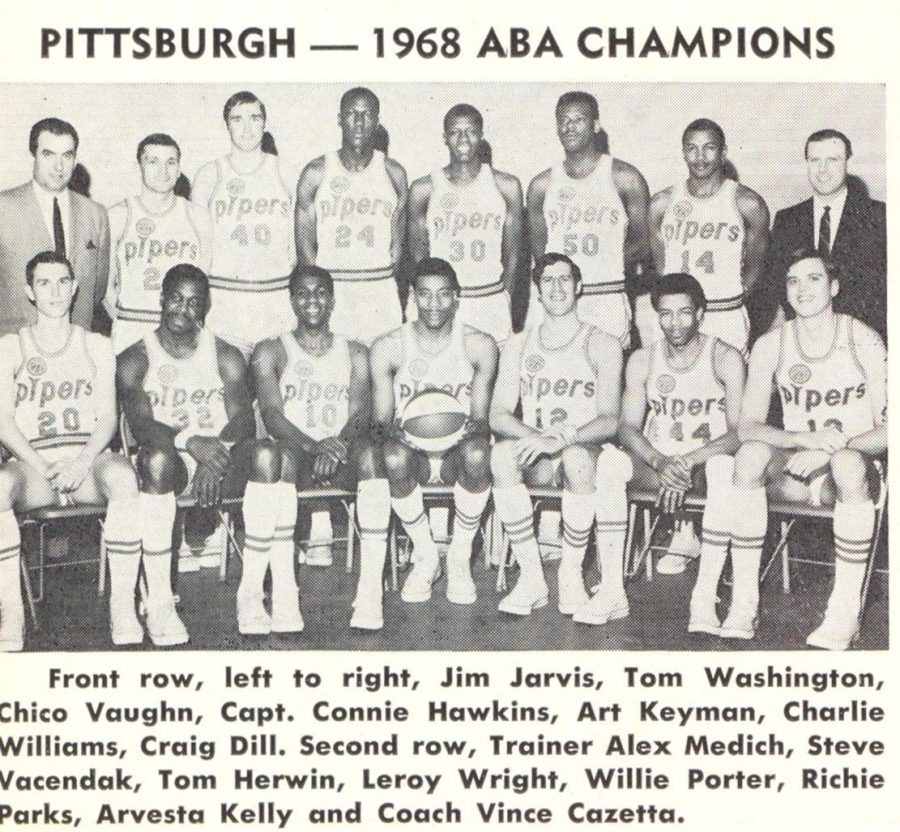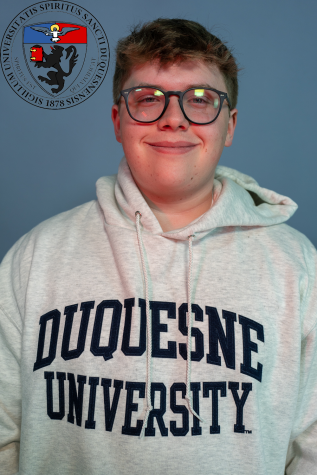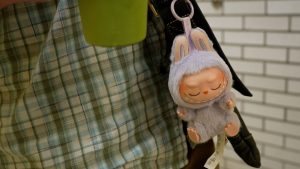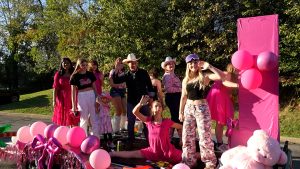Pittsburgh’s Long-Lost Pro Basketball Team
The franchise’s rocky existence might have deprived the Steel City of an NBA team.
The Pittsburgh Pipers lineup upon winning the ABA inaugural championship.
May 17, 2023
In 1976, the National Basketball Association (NBA) merged with the American Basketball Association (ABA). The ABA ceased to exist as a result of the acquisition.
The NBA acquired four out of the six remaining ABA teams that were left at this point. The Denver Nuggets, the Indiana Pacers, the New York Nets, and the San Antonio Spurs were all introduced into the NBA. The remaining two, the Kentucky Colonials and the Spirits of St. Louis, folded.
Had this merger occurred only four years prior, Pittsburgh might have a professional basketball team today.
The Pittsburgh Condors stopped playing after the 1971-1972 season.
Formerly known as the Pittsburgh Pipers, the team was introduced along with the league itself during the ABA’s inaugural season in 1967.
The team found early success, boasting the league’s best record during the regular season, and even winning the ABA’s first ever championship for Pittsburgh.
The Pittsburgh Pipers dominated this first season, led by star player Connie Hawkins, ABA MVP who led the league in scoring at 26.8 points per game.
The Pipers swept through the 1968 ABA Playoffs, defeating the New Orleans Buccaneers at a close fours games to three to win the title.
Somewhat tragically, following the stellar 1968 season, and good attendance at games, the franchise moved to Minnesota for the following ABA season, and for 1968-1969 season, the Minnesota Pipers were in Pittsburgh’s place. The franchise’s location shift was a result of Minnesota’s previous ABA team, the Muskies, being unable to draw large enough attendance.
When the Minnesota Muskie’s migrated down to Miami and became the Floridians, the ABA league office (located in Minneapolis) felt it was best, after a Minneapolis attorney named Bill Erickson bought a majority of the Pittsburgh team, to relocate the team entirely. The Minnesota Pipers made it back to the ABA playoffs once again, but lost to the very Miami Floridians they had replaced in Minnesota.
Attendance from the Muskies to the Pipers didn’t change much, and after one season in Minnesota, the Pipers returned to Pittsburgh because they, according to Pipers co-owner Gabe Rubin, couldn’t think of anywhere else to go.
This season in Minnesota might have stunted the momentum of the Pipers’ success in the first ABA season. Although reaching playoffs during the ‘68-‘69 season, upon returning to Pittsburgh the Pipers did not match the success of previous seasons, and failed to attract fans.
After the 1969-1970 season in which they had returned to Pittsburgh, the team was purchased by Haven Industries, and decided a name change was in order. For the name, a contest was held and the name “Pittsburgh Pioneers” was chosen. Unfortunately, Point Park College’s teams were also known as the Pioneers, and the ABA had to change the name of the Pittsburgh team.
For their final two seasons, Pittsburgh’s professional basketball team would play as the Condors.
The following seasons were tumultuous for the team. Ever-lowering attendance, combined with the Condor’s poor defense, caused prospects of the teams future to fall even more.
To add insult to injury, Condors general manager Marty Blake, in a wild stunt, decided to give away every single available seat for an early season game against Florida in the 1970-‘71 season. This would end being the largest crown the team had ever procured, but they only packed 8,074 of the 12,300 seats in the arena.
The rollercoaster continued on during the 1971-‘72 season, when it was announced that the Condors had successfully lured the Milwaukee Bucks of the NBA to Pittsburgh for an exhibition game, promising the Bucks $25,000.
The Condors believed that Bucks’ star Lew Alcindor would bring added star appeal, allow them to pack the stadium, win the game, and show off the new uniforms they made for this season.
Local advertising for the game proclaimed “Bring on Alcindor,” but only a few days prior to the game, Alcindor had changed his name to Kareem Abdul-Jabbar. Regardless, Kareem was injured at the time of the game and was not present for it, to the dismay of many fans.
The continued failure of the franchise saw attendance levels consistently dropping below 1,000 attendees, and on June 13, 1972, the ABA canceled the Condor’s franchise.
The Condors’ roster was entered into a dispersal draft, with all continuing players entering different ABA teams, with the exception of John Brisker, who joined the NBA’s Seattle Supersonics.
The story of the Pittsburgh Condors is a tragic one, one of many what-ifs in sports history. It’s all too easy to imagine a world where the team never left after the 1968-‘69 season, continued their momentum, and were included in the NBA merger of 1976.
But for now, I will watch the Lakers.














Harold Reemers • Aug 26, 2024 at 7:52 pm
Good Job keep up the good work